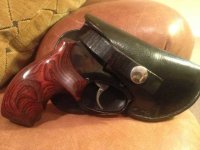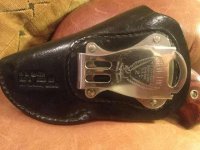I have seen quite a few holsters with the same, or similar, belt clips. These were popular back in the 1950's, 60's, and 70's. There were usually some common traits:
1. Straight drop, neutral cant.
2. Low ride height, grip-frame at or near belt-line.
3. Open trigger guard.
4. Snap-strap retention.
Mens' trouser preferences changed considerably during the 1960's. Trouser "rise" was reduced, waistband located on the hips and a couple of inches below the navel. Before that most mens' trousers had much greater rise, with waistband located above the navel. Suspenders (braces, galluses, whatever you want to call them) were in much more common use. Trouser belts, if used at all, were usually quite narrow.
This change in mens' fashions required a different approach to holsters. Higher ride and butt-forward cant became the norm. Snap-strap retention started losing out to thumb-break retention (later 1960's). Covered trigger guards didn't make much of a dent until the late 1980's, as Glocks and similar striker-fired pistols came into the market (and required more protection against inadvertent/unintentional/accidental discharges).
Decline in the use of suspenders required sturdier belts, both to secure the trousers and to support a holstered handgun.
Not all of these changes occurred simultaneously. While the younger men took to the new fashions more quickly many older men stuck with the older preferences for the next couple of decades.
When I first put on a badge in 1972 most of the senior cops I worked with and for were WW2 and Korea veterans, and their wardrobe preferences were much different than us younger guys liked to wear. A gentleman's business suits still came with two pairs of trousers, usually a vest, and the coat. A good suit could last for 10 or 15 years and they were expensive, so the older guys continued using them as long as possible. The older guys were also accustomed to earlier holster designs, things they had been using for many years and were comfortable with.
The specific clip shown on the OP's holster photos was used pretty widely by a number of makers. I would expect that the larger companies would have insisted on the clip maker stamping their own trademarks and/or names on clips provided for their production. Smaller shops would have used the clips as shown.
Note the term "Nickel Silver" stamped on the clip. Nickel silver is an interesting material in itself, long used in jewelry, flatware, vases, bowls, and other decorative items. The actual composition is an alloy of copper with nickel and zinc, providing the appearance of silver along with some tendencies to oxidize and display tarnish similar to real silver products. Being a relatively soft metal alloy nickel silver is easily cast, punched, or stamped into just about any shape. It is relatively sturdy (relative to overall thickness, of course) but has no inherent qualities suitable for use as a spring; once bent it remains somewhat distorted even when straightened back to original shape. In short, not the ideal material for this type of application. At the upper hinge of the Franz-Loc clip there will be a tempered steel spring providing tension to close the clip and make it grip securely. Steel springs of this era were invariably carbon steel alloys, thus subject to rust, and locating the spring against the body ensured exposure to salty perspiration which, over time, can be expected to damage the spring and compromise the Franz-Loc's ability to perform as intended.
Another interesting example in the history of man's developments for carrying his necessary tools.


